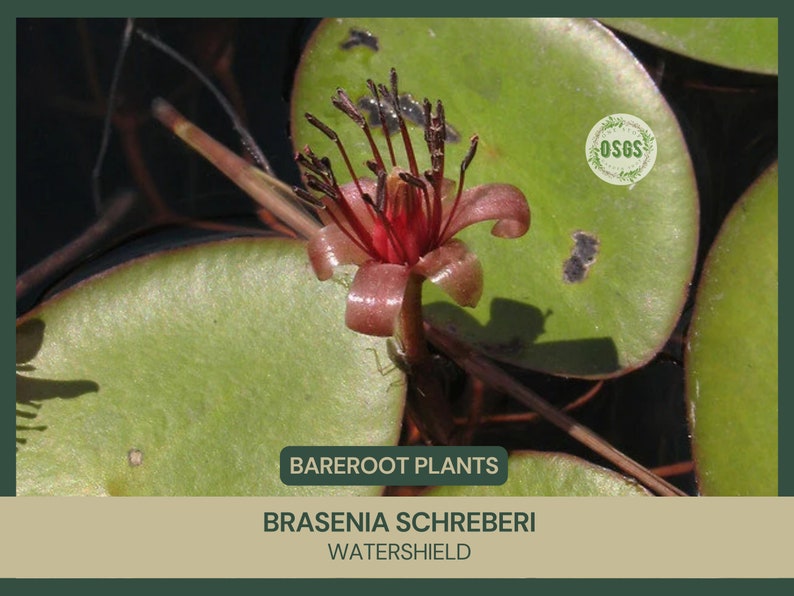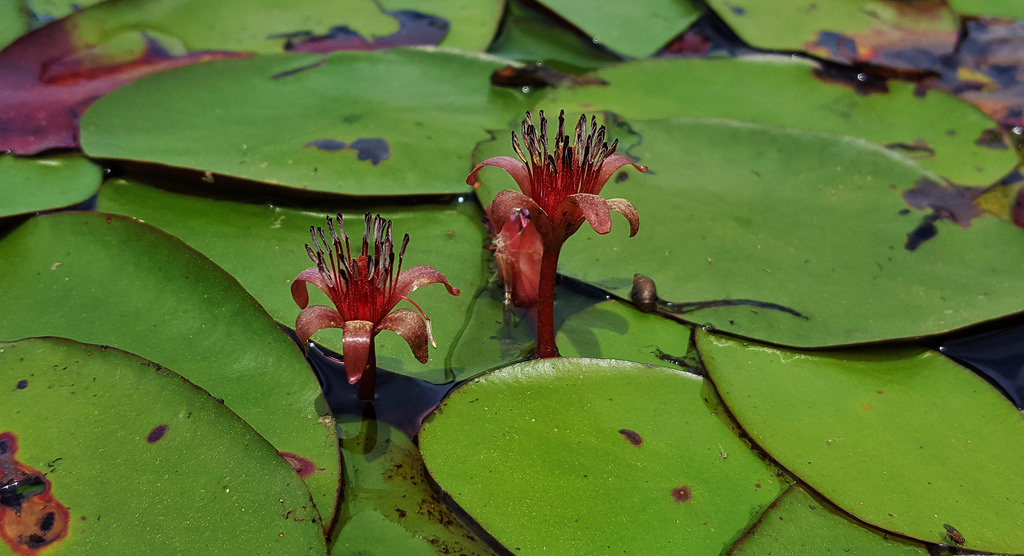
Alisma subcordatum
American Water Plantain
Cultivating Alisma subcordatum for Natural Water Features
● Features floating, elliptical leaves with a distinctive purple underside.
● Thrives in calm, freshwater environments, creating a serene and natural ambiance.
● Offers habitat and shelter for aquatic organisms, contributing to ecosystem balance.
Brasenia schreberi, commonly known as Watershield, is a unique aquatic plant celebrated for its floating leaves and tranquil presence. This perennial is an excellent addition to water gardens, ponds, and other aquatic environments, enhancing the natural beauty of these landscapes.
Plant Care
Brasenia schreberi, commonly known as water shield or pond shield, is a perennial aquatic plant that thrives in still or slow-moving freshwater bodies such as ponds, lakes, and slow streams. It is recognized for its floating, oval-shaped leaves and its underwater stem portions coated with a distinctive gelatinous substance. This plant is not only ornamental but also serves ecological functions in its natural habitat.
Here’s a guide to caring for Brasenia schreberi:
Sunlight Requirements: Prefers full sun to partial shade. Adequate sunlight is crucial for optimal growth and health, although it can tolerate some shade. In too much shade, it may not produce as many leaves or flowers.
Watering Needs: As an aquatic plant, Brasenia schreberi must be grown in water. It is best suited for shallow areas of ponds or water gardens where the leaves can float on the surface while the roots are anchored in the muddy bottom. The plant can tolerate water depths from a few inches up to about three feet.
Soil Type and pH Preferences: Thrives in soft, muddy bottoms typical of natural ponds and waterways. It is not particularly fussy about soil pH but tends to do well in neutral to slightly acidic conditions.
Temperature and Climate Requirements: Hardy in USDA Zones 5-11, Brasenia schreberi can withstand a range of temperature conditions. It is a robust plant that can survive winter in frozen ponds as long as its root system is well below the ice line.
Pruning and Maintenance: Requires minimal maintenance once established. It's important to ensure that the water body does not become overcrowded with other aquatic plants, which could compete for nutrients and light. Occasionally, dead or dying leaves should be removed to keep the plant healthy and prevent decay in the water.
Propagation: Typically propagated by division or from seed. Division is simpler and can be done by separating portions of the rhizome with attached leaves in the spring or summer and replanting them in the mud. Seeds, if available, can be scattered directly into the water in the area where you wish the plants to grow.
Brasenia schreberi is valued for its aesthetic qualities and its usefulness in the ecological management of water bodies. Its leaves provide shade and shelter for aquatic wildlife and can help reduce algae growth by shading the water surface and absorbing nutrients. This plant is an excellent choice for natural ponds and water gardens where it can contribute to a balanced ecosystem while providing visual interest.
Planting and Propagation
Planting Brasenia schreberi, commonly known as Water Shield or Water Nymph, introduces a unique and attractive aquatic plant to your garden's pond or water feature. This perennial plant is known for its floating, oval-shaped leaves that are glossy and often have a gelatinous coating beneath, and for its small, reddish-purple flowers that bloom just above the water surface in summer. Water Shield is valued for its simplicity, its ability to help oxygenate the water, and its role in providing habitat for aquatic wildlife. Here’s how to plant and care for Brasenia schreberi to add both beauty and ecological balance to your aquatic settings.
When to Plant
Best Time: Early spring is the ideal time to plant Water Shield, as the temperatures are starting to warm but are not yet hot, which can help the plant establish without stress. It can also be planted in the fall in warmer climates.
Zone Considerations: Hardy in USDA zones 5-11, Brasenia schreberi is versatile and can thrive in a wide range of climates as long as the water does not freeze to the depth of its roots.
Selecting a Site
Sunlight: Prefers full sun to partial shade. Full sun encourages more vigorous growth and blooming, but in very hot climates, some shade can prevent overheating of the water.
Water Depth: Thrives in shallow water, typically between 1 and 3 feet deep. Ensure it is planted where the water is calm or has only slight movement to allow for stable growth.
Planting Steps
Soil Preparation: Plant directly into the muddy bottom of a pond or in a shallow water container with heavy loam. Avoid using potting soil or any medium that floats.
Planting Depth: Place the rhizomes or rooted plants into the mud so that the roots are well anchored. The leaves float on the surface, so the depth should accommodate the length of the stems.
Spacing: Space plants about 12 to 24 inches apart to allow for spread and coverage across the water surface.
Ongoing Care
Watering: Being an aquatic plant, Water Shield requires no additional watering beyond its placement in a body of water.
Fertilizing: Generally does not require fertilization. If growth is sluggish and water conditions permit, a slow-release aquatic plant fertilizer can be added to the mud to stimulate growth.
Pruning: Minimal maintenance is required. Remove any dead or decaying leaves periodically to maintain the health of the plant and keep the water clean.
Propagation
Division: Easily propagated by dividing the rhizomes in the spring or late summer. Each division should have at least one growing point.
Natural Spread: Water Shield naturally spreads through rhizomes under the water's surface and can quickly cover a small pond if conditions are ideal.
Pests and Diseases
Pests: Generally has few pest issues, though it can occasionally attract aquatic insects which typically do not cause significant damage.
Diseases: Resistant to most diseases, but keeping the water clean and well-oxygenated can prevent any potential problems.
Planting Brasenia schreberi adds a charming and functional element to ponds and water gardens, enhancing the aesthetic with its floating leaves and subtle flowers. Its ease of care and ecological benefits, such as providing shade and shelter for fish and other aquatic creatures, make it a valuable addition to any water feature.
Feeding and Fertilizing
Initial Feeding: Apply a balanced, slow-release fertilizer in early spring as the fern begins to show new growth. A formula with a lower concentration of nitrogen and higher amounts of phosphorus and potassium, such as a 5-10-10 NPK ratio, is suitable to encourage healthy root and frond development without excessive foliage growth.
Soil Preparation: Enrich the soil with well-decomposed organic matter or compost before planting. This will help improve soil structure, increase water retention, and provide a steady release of nutrients, which is ideal for ferns that prefer moist conditions.
Supplemental Feeding: In mid-season, if the fern appears to be underperforming or the soil is less fertile, an application of a liquid, balanced fertilizer diluted to half strength can provide a boost without the risk of burning the delicate fronds.
Avoid Over-Fertilization: Over-fertilizing can be detrimental, leading to weak growth and potential burning of the delicate fronds. It’s important to apply fertilizers sparingly and to avoid high nitrogen content, which can promote lush growth susceptible to pests and diseases.
pH Preference: Athyrium filix-femina prefers slightly acidic to neutral soil (pH 5.5 to 7.0). Maintaining the correct pH is crucial as it affects nutrient availability and overall plant health.
Consistent Moisture: This fern thrives in consistently moist soil conditions. Ensure that the soil does not dry out, especially during hot, dry periods. Mulching around the base of the fern can help retain soil moisture and keep the root system cool.
Shade Requirements: As a woodland plant, Athyrium filix-femina does best in partial to full shade. Too much sunlight can stress the plant, leading to scorched fronds and increased water demand.
By carefully managing feeding and environmental conditions, you can help your Athyrium filix-femina thrive, providing lush, green fronds that enhance the beauty and biodiversity of shaded garden areas.
Seasonal Care
Athyrium filix-femina, commonly known as lady fern, is an elegant and graceful fern native to a wide range of temperate regions. This fern is characterized by its lush, feathery, green fronds that can add a soft, delicate texture to woodland gardens, shaded borders, or damp areas in the landscape. Lady fern is appreciated for its adaptability to different soil types and its relative ease of care, making it a favorite among both novice and experienced gardeners. Here’s how to care for Athyrium filix-femina through the seasons:
Spring
Cleanup: Clear any debris and dead fronds from the previous season to encourage healthy new growth and improve air circulation around the plant.
Planting: If planting new lady ferns, choose a shaded or partially shaded area with moist, well-drained soil rich in organic matter. Spring is an ideal time to plant, as the cooler temperatures and moist soil help the ferns establish.
Watering: Water new plantings regularly to keep the soil consistently moist, which is crucial for the development of young ferns. Established plants also benefit from regular watering during dry spells.
Mulching: Apply a light layer of organic mulch, such as leaf mold or compost, around the ferns to help retain soil moisture and suppress weeds.
Summer
Watering: Continue to ensure that the soil remains moist, especially during hot, dry periods. Lady ferns thrive in damp conditions and can suffer in prolonged dry weather.
Maintenance: Check for signs of pests or disease, though lady ferns are generally trouble-free. Remove any yellowed or damaged fronds to keep the plant looking its best and to prevent potential spread of disease.
Fall
Preparation for Winter: As the ferns begin to die back naturally, you can trim back dead fronds to tidy up the area. However, leaving some fronds can provide winter interest and help protect the crown of the fern through the colder months.
Mulching: Apply a fresh layer of mulch to insulate the roots and crown as temperatures begin to drop. This is especially helpful in colder climates to prevent freeze-thaw damage.
Winter
Monitoring: While lady ferns are dormant during winter, it's important to occasionally check that the mulch is in place and that the soil isn’t drying out completely if there are dry winter spells.
Planning: Consider any adjustments for spring, such as expanding the fern area or adding companion shade-loving plants.
Year-Round Tips
Soil and Site: Lady ferns prefer a shady spot with rich, moist, well-drained soil. They can adapt to varying soil pH levels but thrive in slightly acidic conditions.
Propagation: Divide lady ferns in early spring every few years to manage their growth and rejuvenate older clumps. This is also a great way to propagate new plants.
Companion Plants: Pair lady ferns with other shade-tolerant perennials like hostas, astilbes, and hellebores, or underplant them beneath shade trees such as maples and oaks.
By following these care instructions, your Athyrium filix-femina will thrive, bringing a sense of tranquility and natural beauty to the shaded or woodland areas of your garden.
Plant Uses
● Creates a tranquil surface layer, reducing water turbulence and enhancing visual appeal.
● Provides shade and refuge for aquatic creatures, supporting a balanced ecosystem.
● Adds a unique touch to aquatic landscapes with its floating leaves and purple undersides.
Brasenia schreberi serves both practical and aesthetic purposes in water gardens.
Varieties and Cultivars
Brasenia schreberi, commonly known as watershield or water shield, is an aquatic plant native to wide regions of the Northern Hemisphere, including parts of North America, Asia, and Australia. It thrives in still or slow-moving freshwater environments such as ponds, lakes, and slow rivers. Watershield is notable for its distinctive gelatinous coating on the underside of its leaves and stems, which helps protect the plant from predators and pathogens.
Characteristics of Brasenia schreberi:
Appearance: This aquatic plant features floating, oval to elliptical leaves that are glossy green on the top and coated with a slimy, jelly-like substance underneath. The leaves are attached to long, flexible stems that connect to a submerged rhizome.
Flowers: Watershield produces small, reddish-purple flowers that rise just above the water surface. These blooms are generally solitary and appear in the summer.
Growth Habit: The plant forms a floating mat of foliage that can cover significant areas of the water surface in suitable conditions, providing shade and habitat for aquatic life.
Growing Conditions and Habitat Preferences:
Light: Prefers full sun to partial shade. Adequate light is essential for good growth, although it can tolerate moderate shade.
Water: Must be grown in aquatic environments, either partially or fully submerged, with water depths typically ranging from a few inches to several feet.
Soil: Anchors itself in the muddy bottoms of ponds, lakes, or slow-moving rivers.
Ecological Benefits and Uses:
Habitat: Provides habitat and shelter for aquatic organisms, including fish and invertebrates. The dense mats can also help stabilize shorelines and reduce erosion.
Water Quality: Helps improve water quality by competing with algae for nutrients, thereby potentially reducing algal blooms.
Ornamental Use: Can be used in water gardens or ponds for its ornamental flowers and interesting foliage. Its ability to form dense mats also makes it useful for covering bare spots in aquatic settings.
Care and Maintenance:
Brasenia schreberi is generally low maintenance once established in a suitable aquatic environment. It may need to be managed to prevent it from covering too large an area, as it can spread quickly under ideal conditions.
In colder regions, it can die back to the rhizome in winter and return in the spring. In warmer climates, it may remain evergreen throughout the year.
While Brasenia schreberi is beneficial for aquatic ecosystems and ornamental water features, it should be introduced with care, as it can become invasive under the right conditions. Its natural beauty and ecological functions make it a valuable plant for enhancing biodiversity in managed freshwater systems.

Growing Tips and Tricks
● Choose a location with minimal water movement to maintain the plant's floating habit.
● Regularly monitor water quality, especially nutrient levels, to ensure a healthy aquatic environment.
● Consider companion planting with other aquatic plants for a harmonious and vibrant water garden.
Additional tips ensure a thriving water garden with Watershield.
Troubleshooting Common Problems
● Yellowing leaves may indicate nutrient deficiencies or poor water quality.
● Sparse growth may result from insufficient sunlight or overcrowding.
● Regularly remove debris and decaying leaves to prevent water contamination and maintain a pristine appearance.
Proactive troubleshooting can maintain the health and tranquility of Watershield.










